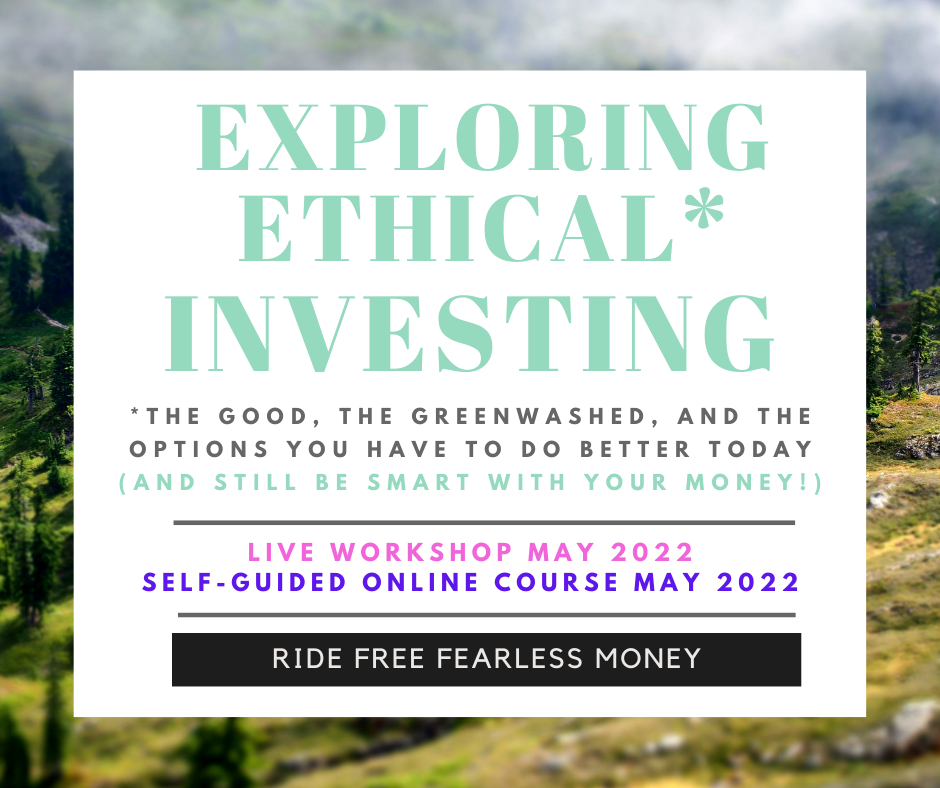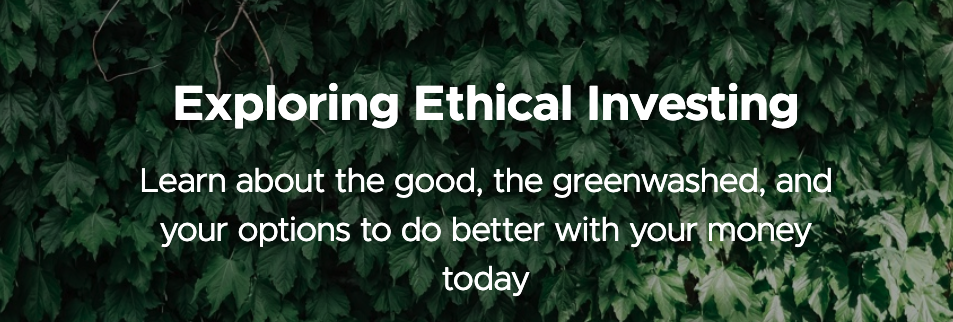
Investing is a way to solve the problems of…
- Having money when you aren’t working for it -> everything costs more each year - inflation - so in order to maintain the purchasing power of money, you want to invest it where it can earn at least as much as inflation
- Having choices -> it’s not right that money enables choices, but it’s true. You deserve the dignity of choice, like we all do.
But ‘investing’ can feel … bad
Many of us want more out of life - and our investments - than “make the most money possible.”
We want to have money SO we can eat healthily, support our communities and causes,
and have options and choices. We want to support businesses that treat employees fairly, don’t pollute, and which are creating future-forward tech and social innovations. We want away from businesses that fund oil-fueled ecological destruction, human harm, or social injustices. It’s not clear how to accomplish these seemingly at-odds goals.
So, knowing your options and setting YOUR values, vision, priorities and goals can help YOU outline your path forward clearly.
This workshop gives you just that: financial education, a summary of options, and exercises to help you set your vision and path.
Read on if you’re wondering about how to identify money to invest, and put money into investments that have nothing to do with sneaky greenwashing so your money can do some good
A few months ago I noticed that the stock market was heading back up, but I had been dilly-dallying and did not invest some money I’d been meaning to, so I lost out on an 8% increase.
I have automated investing contributions going and had other money in the market, so I was able to see gains on that money. But it got me thinking about what makes it hard to apply butt to chair and call or click to move money when it’s to non-urgent things like My Far Future.
MY PLAN ON HOW TO INVEST THIS MONEY
Firstly, I assessed my financial position and decided that I want and need to have money for myself in the future, and I need that money to be worth enough so that in the future I can use that money to take care of myself.
So, I have most of my money invested to earn financial returns, and I pick investments that are the most climate and socially conscious I can access with ease. And, because I have extra money, about 5% of my money goes to donations and investments that don’t create financial returns, more focused on mutual aid and environmental/social impact.
For this investment round
While this is not advice about what anyone else should do, what I am doing with this money is putting 90% into an ESG fund at CarbonCollective which should earn me money in the long term, and 10% into a specific impact investment or two – not exactly sure which but I am learning about regenerative energy, B-corps, and green construction a lot these days, so will invest somewhere in there, and I don’t know if these will make me money in the long term.
I’m choosing this based on my assessment of my needs and position, and because I am guessing I’ll want to use this money in 5-10 years, for a big project I have in mind. Since I felt stung into motivation to procrastinate no longer, I was happy to get some inspiration on what to invest this dilly-dallied money into by being on a panel on impact investing [watch the replay here – more info below].
PRACTICAL CONSIDERATIONS IF YOU WANT TO DO IMPACT INVESTING
How much money?
Q: How do I figure out what amount of my investing portfolio or savings should go towards activist / community investments and riskier or lower-return impact investing?
Hint: there are LOTS of “right answers”
A: It depends on how much money you have, that you don’t need financially working for you. Think about money you’re willing to donate, that would be a cool bonus if it made you money back.
Here’s the thing: some impact investments are designed to make you money – an ESG fund at CarbonCollective or Betterment for example; but many of them will return less than inflation – which means losing financial value but generating environmental and/or social benefits instead. And, some of these might end up companies or projects that tank, whereby all the money is lost. Investing is about spreading out your money
For some of you, on these streets trying to get your first emergency fund saved, the answer is $0 – get that oxygen mask on first. For you with inherited wealth that’s sitting around, the answer can range from 10-90% of your money. In my example above, 5% of my investing/extra money goes places that don’t necessarily return money.
For those of us in the middle, with some savings and investments, but who are not financially independent, the first step is to identify money you don’t need this year: that’s money you could invest – into a retirement account, or a personal brokerage account. Within that, one rule of thumb some people follow is to put 5-10% of your investing money into riskier investments, eg ones that might not make you any money.
Whether you decide to put all your investing money into impact investments or not also is going to depend on the amount of time and gumption you have to move things around, open new accounts, etc.
How to find an impact investment
To make it achievable, I like to start with ONE investment and either a one-time amount to invest OR a manageable recurring monthly automated investment.
First – what’s one issue that stands out to you today: climate? Reproductive rights? Ending private prisons? Pick one – JUST ONE – to focus on.
RSF has a respected fund that gives loans to social impact entrepreneurs as well as donor advised funds; RaiseGreen is a platform allowing everyone in the US a way to find and invest directly in climate solutions, and GreenPortfolio is a fintech app supporting you in scoring the impact of your finances and finding financial products that fix – instead of harm – the environment.
If you want to dive into your investing options, my 90-minute workshop on Exploring Ethical Investing is available on-demand!
HOW MUCH!
Finally, you need to decide exactly how much of your investing money you’ll put towards the investment you choose.
For example, $1000 into a green climate bond, renewable energy stock, or social impact fund.
Or
$100 every month automatically invested into a climate-focused ESG fund.
Financially investing vs semi-donating?
Remember – some of these investments are not designed to give impressive financial returns – anything with an average return between 3-5% will simply keep up with inflation, so returns lower than that lose financial value on the money over time.
It’s ok to choose investments for their non-financial returns! I do want you knowing what you’re doing 🙂 — so, when choosing investments simply look at a few [not so many you freeze!] different options out there, and at expected return in particular so you know what to expect.
CONCLUSION
At the end of the day, the amount you invest is up to you – as is the fund or other product you choose. What matters is scaling it down so you do it, and get it done!
So, is it a good time or a bad time to invest? Regardless of externalities, your answer depends on what you need that money to do for you, and WHEN.
Learn more!
My 90-minute workshop on Exploring Ethical Investing is available on-demand, sign up today to learn more about your investing options!

On Thursday 8/11/22 I’m on an all-women-in-finance FREE webinar with folks from Raise Green, GreenPortfolio, and RSF Social Finance on how to drive social and environmental impact through your finances and investments!
I’m talking about practical things: defining impact for yourself, identifying money you might invest, considerations for non-wealthy folks who want to make impact AND money, and getting yourself to take action, and the others are sharing tools and products that might fire you up to put that money out there to do good and make financial AND social or environmental impacts!
Register for this free event at https://info.raisegreen.com/impact-investing-webinar
##